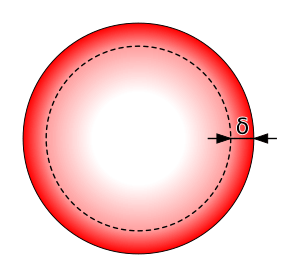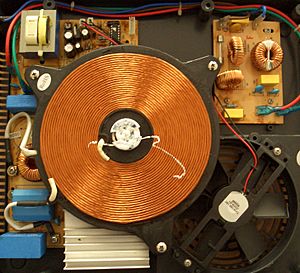Skin effect facts for kids
The skin effect is a cool science trick that happens when electricity flows through a wire. Imagine an alternating current (AC) trying to move through a metal wire. Instead of spreading out evenly, the electricity tends to hug the outside "skin" of the wire. The center part of the wire ends up carrying very little or almost no electricity.
Contents
What is the Skin Effect?
The skin effect makes electric current flow mostly near the surface of a conductor. This happens when the current is an alternating current (AC), meaning it constantly changes direction. The higher the frequency of the AC, the more the current gets pushed to the outside edge.
Why Does Current Stick to the "Skin"?
This interesting effect happens because of how electricity and magnetism are connected. When an alternating current flows through a wire, it creates a changing magnetic field around and inside the wire. This changing magnetic field then creates its own small electric currents, called "eddy currents," within the wire itself.
How Eddy Currents Push the Main Current
These eddy currents flow in a way that actually opposes the main current, especially in the center of the wire. Think of it like two forces pushing against each other. The eddy currents are strongest in the middle of the wire, where they effectively "cancel out" some of the main current. This forces the main current to take the path of least resistance, which is closer to the surface where the opposing eddy currents are weaker.
What Does the Skin Effect Do?
The skin effect has some important consequences for how we use electricity. Because the current is forced to flow only through the outer part of the wire, it's like the wire suddenly becomes "thinner" for AC electricity.
Increased Resistance and Heat
When the current is squeezed into a smaller area, the wire's resistance to the flow of electricity goes up. This increased resistance means that more energy is lost as heat. For example, if you have a wire carrying AC, it might get hotter than the same wire carrying direct current (DC) because of the skin effect. This can be a problem in power systems, as it wastes energy.
Where is the Skin Effect Important?
The skin effect becomes more noticeable at higher frequencies. This means it's a big deal in some technologies but less so in others.
High-Frequency Electronics
In things like radio transmitters, computer circuits, and wireless communication devices, the electrical signals change direction very, very quickly. These are high-frequency currents, so the skin effect is very strong. Engineers have to design these circuits carefully to make sure the electricity can flow efficiently.
Power Transmission
For the electricity that comes out of your wall sockets (which is usually 50 or 60 Hz), the skin effect is present but not as extreme. However, for very thick cables used in power transmission, it can still cause some energy loss.
Skin Effect in Induction Cookers
A great example of where the skin effect is important is in Induction cookers. These cookers use very high-frequency alternating currents (around 25,000 to 50,000 Hz) to create heat. The coils inside the cooker are specially designed using something called "Litz wire" to reduce the skin effect and prevent the coils themselves from getting too hot.
How Engineers Deal with the Skin Effect
Engineers have come up with clever ways to reduce the problems caused by the skin effect.
Using Litz Wire
One common solution is to use Litz wire. This isn't just one solid wire; it's made up of many tiny, insulated strands woven together. Each tiny strand is so thin that the skin effect doesn't have much impact on it. Because the strands are insulated from each other, the current can spread out more evenly among them, even at high frequencies. This helps reduce resistance and heat loss.
Hollow Conductors
For extremely high frequencies, sometimes engineers even use hollow tubes instead of solid wires. Since the current mostly flows on the outside anyway, a hollow tube can save on material while still carrying the current effectively.
Images for kids
-
Current density in round wire for various skin depths. The numbers on each curve show how skin depth compares to wire radius. The infinity sign curve is for direct current (DC). All curves are adjusted so the current density at the surface is the same. The horizontal line shows position in the wire, from surface to surface. The vertical line shows how much current is flowing.
See also
 In Spanish: Efecto pelicular para niños
In Spanish: Efecto pelicular para niños





